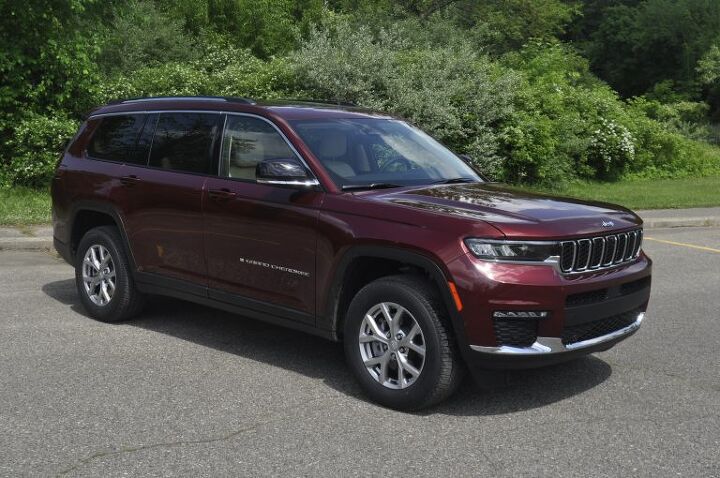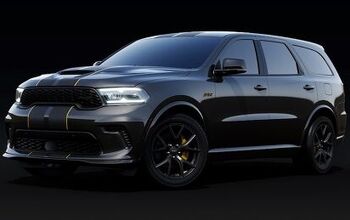2021 Jeep Grand Cherokee L First Drive - The Three-Row for the Jeep Stan

Jeep has offered all sorts of different utility vehicles over the years – it’s sort of the brand’s thing – but it hasn’t recently offered a three-row crossover. The last one it sold was the Commander, which left the market a decade ago.
I quite honestly forgot the Commander even existed – and I started in automotive journalism in 2007. While it was still on the market. I suspect most Jeep faithful have also memory holed that model.
That’s unlikely to happen with the 2021 Jeep Grand Cherokee L, for better or for worse.
(Full disclosure: Jeep hosted me in a nice hotel in downtown Detroit and provided meals (including some excellent booze with dinner). The company offered a hat which I did not take. We also toured the Mack Avenue plant where the Grand Cherokee L will be built. No flight, as Detroit is within driving distance.)
The L isn’t just a stretched Grand Cherokee – Jeep calls it an “all-new vehicle architecture” in the media materials. The new unibody GC L will sell alongside the current two-row version for now, with the five-seater slated for replacement soon – probably for next year. Jeep folks tell me the new architecture is meant to facilitate electrification.
The exterior design is refreshed and the cabin is revamped. Nothing too crazy, though – the signature seven-slot grille is retained, and it’s clear at first glance that you’re looking at a Grand Cherokee.
Just one that’s a bit longer. Unfortunately, that extra length looks a bit awkward from some angles.
Jeep being Jeep, there are three available four-wheel-drive systems. Quadra-Trac I has a single-speed active transfer case, Quadra-Trac II has a two-speed active transfer case with low-range gear reduction, and what Jeep calls Active 4-Low torque control and a 2.72:1 gear ration. Quadra-Drive II is a two-speed active transfer case with a rear electronic limited-slip differential. There are five drive modes for varying terrain – Auto, Mud/Sand, Rock, Sport, and Snow.
Meanwhile, the front and rear suspensions are independent (the rear is multi-link), and the available Quadra-Lift air suspension offers adaptive damping and 10.9 inches of ground clearance, with water-fording capability of up to 24 inches.
There are two engines to choose from – the venerable 3.6-liter Pentastar V6, making 293 horsepower and 260 lb-ft of torque here, and the also-respected 5.7-liter V8. The latter makes 357 horsepower and 390 lb-ft of torque in this application, and Jeep promises a max towing capacity of up to 7,200 pounds.
A front-axle disconnect is supposed to reduce driveline drag and improve fuel economy.
LED lighting all around is now standard on all trims, and there are eight wheel choices, including 21-inches for the first time.
Among the interior changes: Standard 10-inch digital displays, LED ambient lighting, and available seat-back massage.
There are several trim levels – Laredo, Altitude Package, Limited, Overland, Summit, and Summit Reserve Package. If you want a V8 – and as you’ll see below, you really should – you need to get an Overland or greater.
Your humble scribe hopped into a pre-production Limited before departing Detroit’s famed Eastern Market for Chrysler’s Stellantis’s Chelsea Proving Grounds outside of Chelsea, Michigan. Our route would take us out of Detroit via freeway before moving us over some country roads en route to the proving grounds.
I found the V6 fine for urban driving and easy freeway merging, but I needed to make a full-throttle pass on I-96 and found it lacking. Dropping my right foot to the floor summoned a lot of noise but not a lot of actual acceleration. It’s probably worth it to spring for the V8 – a $4K price increase over a V6 4×4 on the trims in which it’s available, and not available with two-wheel drive – despite the fuel-economy costs you’ll pay.
Other dynamic flaws present themselves. The Grand Cherokee L exhibited a little too much body roll for my liking when cornering. To be fair, few soccer parents will ever blitz a backroad in this thing (eagle-eyed readers will note, based on the pictures, that we used part of the same route that I drove while testing the Volkswagen Taos last month), but body roll was also present in milder maneuvering, such as following gentle freeway curves or adjusting your lane line, though it was less noticeable. Sport mode made the proceedings only mildly sportier.
I also found the computer nannies that are supposed to keep you in your lane to be a little too aggressive.
The experience isn’t all bad – the GC L rode with admirable compliance and Detroit’s famed broken pavement didn’t trouble it. The cabin was also quite quiet – this vehicle will make for a good interstate road-tripper.
It’s not a Jeep event if we don’t go off-road, and so we did. As per usual, no automaker will put journalists on a course its car can’t handle, but this setup was trickier and gnarlier than what Nissan put us through with its Pathfinder a few weeks prior. It showcased the electronic trickery and the five terrain modes – especially Rock – well enough, with the Grand Cherokee hardly sweating. It probably can’t do what a Wrangler Rubicon or Gladiator Mojave can, but it still seemed quite capable in the boonies, factoring in Jeep’s control of the playing field.
I did try to get my overfed body into the third row, with mixed results. It was a bit harder to get back there than it was in the Pathfinder, though manageable, and headroom was plentiful for my six-foot-one frame. However, legroom was so tight that I’d not want to ride back there for more than a few minutes. Shorter adults will be OK, but the third-row mostly remains the domain of the youths.
This Jeep gets the new Uconnect infotainment system, and it’s one of the more impressive elements of the GC L. It’s intuitive to use, with near-instant transitions from one menu to the next. It’s also customizable.
The rest of the cabin also struck me as pleasant, with eye-pleasing materials that felt price-appropriate. I liked the digital gauge display and its ability to easily switch from an analog look to a style more appropriate for our digital era. It’s easy to quickly dial up key info.
Available features include wireless Apple CarPlay and Android Auto, head-up display, digital rearview mirror, rear-seat monitoring camera, premium audio, hands-on Level 2 automated driving, 360-degree and night vision cameras, cooled first- and second-row seats, Intersection Collision Assist, Drowsy Driver Detection, Traffic Sign Recognition, Parallel and Perpendicular Park Assist, full-speed collision warning with active braking and pedestrian/cyclist detection, rear cross-path detection, adaptive cruise control, active lane management, LaneSense lane departure warning with lane-keep assist, blind-spot monitoring, ParkAssist with rear-view camera, ParkSense rear park-assist sensors, and electronic parking brake.
Fuel economy for the V6 4×4 I drove is listed at 18/25/21. For two-wheel-drive models it’s 19/26/21 and for the V8 it’s an eye-popping 14/22/17.
Pricing starts at $36,995 for a Laredo. It climbs to $40,195 for the Altitude Package, $43,995 for a Limited, and $52,995 for the Overland. A Summit will set you back at least $56,995, and the extra-luxurious Summit Reserve Package rings the bell at $61,995. Add $2K to those prices for four-wheel drive, and add $4K over the price of a V6 4×4 if you want a V8 and it’s available on your preferred trim.
The Summit Reserve is 4×4 only. Destination is $1,695 and not included in those prices above.
My option-laden Limited, which included some of the features listed above (many were part of the $2,295 Luxury Tech Group II package, which added other features such as cooled front seats and an off-road camera) and added panoramic sunroof and Uconnect navigation, cost $53,815.
I’m hard-pressed to recommend the Grand Cherokee L over the five-seat version, especially with the Wagoneer on the way and the five-seat version slated to join the L on this new architecture soon. But if you love the Grand Cherokee’s tendency to mix upscale features and off-road capability and simply must have a third row of seating, you’ll find it to be a nice road-tripper.
What’s New for 2021
The 2021 Jeep Grand Cherokee L is a three-row unibody SUV on an all-new platform for the Grand Cherokee’s fifth generation. It’s separate from the fourth-generation Jeep Grand Cherokee, which remains on sale. The two-row GC will transition to this new platform soon.
The new L offers V6 or V8 power, two- or four-wheel drive, a new infotainment system, and other new features.
Who Should Buy It
The Jeep fan who really, really needs three-row seating.
[Images © 2021 Tim Healey/TTAC]

Tim Healey grew up around the auto-parts business and has always had a love for cars — his parents joke his first word was “‘Vette”. Despite this, he wanted to pursue a career in sports writing but he ended up falling semi-accidentally into the automotive-journalism industry, first at Consumer Guide Automotive and later at Web2Carz.com. He also worked as an industry analyst at Mintel Group and freelanced for About.com, CarFax, Vehix.com, High Gear Media, Torque News, FutureCar.com, Cars.com, among others, and of course Vertical Scope sites such as AutoGuide.com, Off-Road.com, and HybridCars.com. He’s an urbanite and as such, doesn’t need a daily driver, but if he had one, it would be compact, sporty, and have a manual transmission.
More by Tim Healey
Latest Car Reviews
Read moreLatest Product Reviews
Read moreRecent Comments
- Turbo Is Black Magic My wife had one of these back in 06, did a ton of work to it… supercharger, full exhaust, full suspension.. it was a blast to drive even though it was still hilariously slow. Great for drive in nights, open the hatch fold the seats flat and just relax.Also this thing is a great example of how far we have come in crash safety even since just 2005… go look at these old crash tests now and I cringe at what a modern electric tank would do to this thing.
- MaintenanceCosts Whenever the topic of the xB comes up…Me: "The style is fun. The combination of the box shape and the aggressive detailing is very JDM."Wife: "Those are ghetto."Me: "They're smaller than a Corolla outside and have the space of a RAV4 inside."Wife: "Those are ghetto."Me: "They're kind of fun to drive with a stick."Wife: "Those are ghetto."It's one of a few cars (including its fellow box, the Ford Flex) on which we will just never see eye to eye.
- Oberkanone The alternative is a more expensive SUV. Yes, it will be missed.
- Ajla I did like this one.
- Zerofoo No, I won't miss this Chevrolet Malibu. It's a completely forgettable car. Who in their right mind would choose this over a V8 powered charger at the rental counter? Even the V6 charger is a far better drive.










































Comments
Join the conversation
Jeep & RAM desperately need access to more powertrain options, particularly Jeep. The Pentastar V6 is fine in a rental Charger, but overmatched in a Grand Cherokee or this new larger and heavier version requiring way too many revs to make any power. The Hemi is a decent performer but heavy, thirsty and getting out-classed by Ford and GM and perhaps the upcoming Toyota Twin-Turbo V6. Ford has had great success with the turbo V6, the Pentastar would benefit from strengthened internals and a couple small turbos. The 5.7L and 6.4L Hemi's could be recast in aluminum for a weight savings and improvements to it's breathing could bump both the power and efficiency. FCA did a good job on the chassis and interior of these new vehicles, don't let the engines let down an otherwise solid product.
As the owner of a Grand Cherokee Overland from 2014, I won’t be trading it in any time soon for a new one..why? Because mine is powered by the Ecodiesel. Last weekend I took our 24’ trailer 400 miles, something that couldn’t even be done by the current pentastar, and the fuel economy of the hemi is laughable. With a simple stage one delete I have 280hp and 480lb/ft available almost off idle, which running light can get me into the 30mpg club, and pulling a 7000 lb trailer can still get me 18mpg. This would be the only engine choice that would get me to consider buying another one...Jeep are you listening ?